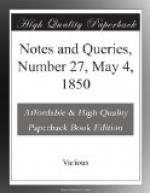“calculated on the supposition, that the registered baptisms, burials, and marriages, on an average of three years, in 1570, 1600, 1630, 1670, 1700, and 1750, bore the same proportion to the actual population as in the year 1801.”
From the Table, pp. 36, 37, it appears, that whilst the population (estimated) in the thirty years 1600-1630 increased upwards of 16 percent., in the forty years 1630-1670 it increased a mere trifle over 3 per cent. only. In no fewer than twenty English counties, the population, estimated as before, was absolutely less in 1670 than in 1630; and in Kent, the county in which Chart is situate, the decrease is striking: population of Kent in 1630, 189,212; in 1670, 167,398; in 1700, 157,833; in 1750, 181,267; and in 1801, the enumerated population was 307,624.
Your correspondent might also find it useful to consult Sir William Petty’s Political Arithmetic, the various documents compiled at the different censuses, and the Reports of the Registrar-General.
ARUN.
* * * * *
PARISH REGISTER STATISTICS.—CHART, KENT.
Your correspondent “E.R.J.H.” (No. 21. p. 330.) inquires whether any general statistical returns, compiled from our early parish registers, have been published. It must be a matter of regret to all who are acquainted with the value of these national records—which for extent and antiquity are unequalled in any other country—that this question cannot be answered affirmatively. By the exertions of the late Mr. Rickman, their importance, in a statistical point of view, has been shown, but only to a very limited extent. In 1801, being entrusted with the duty of collecting and arranging the returns of the first actual enumeration of the population, he obtained from the clergyman of each parish a statement of the number of baptisms and burials recorded in the register book in every tenth year from 1700, and of marriages in every consecutive year from 1754, when the Marriage Act of George II. took effect. The results were published with the census returns of 1801; but, instead of each parish being separately shown, only the totals of the hundreds and similar county divisions, and of a few principal towns, were given. In subsequent “Parish Register Abstracts” down to that of 1841, the same meagre information has been afforded by an adherence to this generalising system.
In 1836, with a view of forming an estimate of the probable population for England and Wales at certain periods anterior to 1801, Mr. Rickman, acting upon the result of inquiries previously made respecting the condition and earliest date of the register books in every parish, applied to the clergy for returns of the number of baptisms, burials, and marriages registered in three years at six irregular periods, viz. A.D. 1570, 1600, 1630, 1670, 1700, and 1750. The clergy, with their accustomed readiness to aid in any useful investigation, responded very




